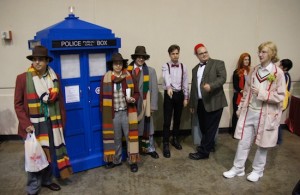What do you consider to be the most successful and problematic aspects of the submitted work?
One of the successful aspects of this project was finding clarity or as Samuel Beckett once said, ‘To find a form that accommodates the mess, that is the task of the artist now’. Our project was on audience – a rather nebulous label – and once we indentified three aspects of it (online fandom, event fandom and trolling) our project became relatively easy and we assigned each one of these aspects to each other to investigate.
Originally, we had agreed to cover cosplayers but as no events were within our project time and cosplayers were hard to get hold of, it was becoming obvious we might have to change tact. Fortunately, a Doctor Who fan event, The Whoniverse, came up which not only provided a rich source of material such as cosplayers to interview but also a plethora of academic papers on Doctor Who fandom as well as an active online community.
The only downside was that due to the short notice of the event, neither Georgia nor Grace could help film. Therefore, I was left to operate the camera and interview on my own and you can see that the camera work isn’t the best as I try to engage and keep an eye on the viewfinder. Having said that, I still really enjoyed the day, as the camera allowed access to people that normally wouldn’t be available to me. Also, working alone allowed me to move independently and make decisions quickly.
Once I had the footage, the difficult part was of course making it into a cohesive piece – difficult as I had over 50 minutes. Even though I had prepared questions I often deviated and didn’t always ask the same question I’d asked other interviewees. This reduced the likelihood of consistency and so by using voiceovers (the most difficult part of the process due to my awful acting ability) I was able to create a cohesive through-line.
However, in regards to producing a uniform work for the whole project I am not sure we achieved this. This is not entirely the collaboration at fault here but bad timing with the event and our own commitments. Thus, the videos for each of our aspects of fandom are quite different in form, tone and style to each other. Likewise, the text on the Tumblr website does not connect as well as it could. We could’ve allocated someone to produce the text but that would’ve been an enormous undertaking for one individual even with research provided for them.
What you learnt in the making process about collaboration that might be relevant to your broader development as a media practitioner?
I’ve collaborated on numerous projects before whether that be writing a script with a friend (never again!), small films or theatre pieces. In short, it’s not easy. Creative differences, expectations and sheer personality clashes can make a collaboration…not a collaboration!
Having said that, I am happy to say that the Project 4 collaboration was a relative success – relative in terms that there were no disputes. Both Grace and Georgia were wonderful to work with and I think that comes down to their well-balanced personalities and eagerness to do a good job. I do have a tendency to take over (wouldn’t say dominate!) and I’ve learnt over the years to keep this in check by framing my language with, ‘As a suggestion, how about this…?’ Even when I pushed for our group to do a documentary as our sole media artefact and they responded less than enthusiastically, I conceded that I was out voted and acquiesced to a webpage that incorporated visual and textual elements.
In the end, we worked to each others’ strengths: Georgia was good at film editing and resourcing while Grace was good at writing and putting the Tumblr account together. I was able to provide numerous papers on the subject and provide the raw film footage. If we were to do another project together, now knowing each others strengths, I think we would be able to formulate a more cohesive piece.
Looking more broadly as a media practitioner, this experience has taught me that I am flexible, I can work independently if I need to and that collaborating invites different points of view as well as experiences. It is, to conclude, a diverse and satisfying media experience and I may see myself making similar and larger documentaries in the future.


